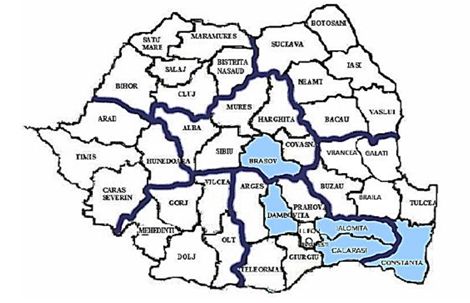The project will increase provision of safe drinking water and collection and treatment of waste water by improving and extending water supply and sewerage infrastructure in six Romanian counties: Braşov, Călăraşi, Constanţa, Dâmboviţa, Ialomiţa and Ilfov.
- 08 February 2021
By raising connection rates to water supply and sewerage systems that meet legal requirements to 99.66 % and 96.57 % respectively, the upgrades will help to fulfil obligations under Romania’s Treaty of Accession to the EU and relevant EU directives.
Currently, the connection rate to water supply systems in the project area is 90.63 % (around 600 000 inhabitants), with 50.22 % (some 335 000 inhabitants) having access to a supply that complies with legal requirements.
Connection rates to waste water collection systems will increase from 76.06 % to 96.84 % in larger settlements (those producing volumes of sewage equivalent to the volumes normally produced by over 10 000 people) and from 25.62 % to 93.86 % in smaller settlements.
Work on new and existing infrastructure
The investments cover 40 water supply systems: 32 in Constanţa county, five in Ialomiţa county and one each in Călăraşi, Braşov and Dâmboviţa counties, the last of which is supplied from a source in Ilfov county.
In all, 29 water sources, 44 water treatment stations, 21 storage tanks and 26 water pumping stations will be set up. Thirteen sources, four treatment stations, 24 storage tanks and 20 pumping stations will be renovated. Also, 200 km of trunk main, 3 km of water main and 144 km of distribution pipe will be laid; while 71 km of trunk main, 41 km of water main and 266 km of distribution pipe will be rehabilitated. A supervisory control and data acquisition (SCADA) system will be developed for 14 local control rooms.
For waste water infrastructure, 403 km of sewerage network and 103 km of discharge pipe will be laid, and 39 km of sewerage network and 32 km of discharge pipe will be rehabilitated. Renovations will be undertaken at 12 waste water pumping stations, and 126 new stations will be built.
Waste water treatment plants (WWTP) will be established at Băneasa, Căzănești, Jegălia and Negru Vodă. A mechanical pre-treatment plant at Năvodari, a retention basin at Medgidia WWTP and a dewatered sludge drying facility at Constanţa South WWTP will also be set up. In addition, the project provides for development of a SCADA system for 17 local control rooms.
Further elements of the work include improvements to existing equipment and purchase of new machinery for maintenance and operation. A total of 156 permanent jobs will be created.
Safeguarding health and the environment
The area’s water supply systems suffer from high losses, sources with low flows and poor water quality, inappropriately treated water, a lack of storage capacity and sensitivity to climate change.
Waste water infrastructure deficiencies include low levels of network coverage in some areas, worn out pipes, high levels of infiltration, clogging of collectors, frequent network failures, high repair costs and discharge of untreated waste water. Other issues are the lack of efficient sludge management and of a recovery and treatment facility for dewatered sludge.
By preventing discharge of untreated waste water, the project will cut river and groundwater pollution, make drinking water safer and reduce the risk of disease, stimulate biodiversity and development of commercial and recreational activities, and support irrigation in agriculture. The upgrades will conserve water by reducing losses from supply systems.
Total investment and EU funding
Total investment for the project “Regional project for the development of water and waste water infrastructure in the operating area of SC Raja Constanţa SA” is EUR 553 586 415, with the EU’s Cohesion Fund contributing EUR 369 899 153 through the “Large Infrastructure” Operational Programme for the 2014-2020 programming period. The investment falls under the priority “Development of environmental infrastructure under conditions of efficient resource management”.

